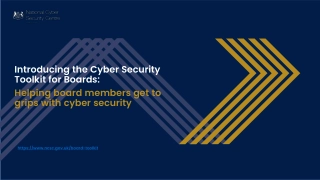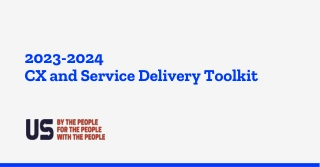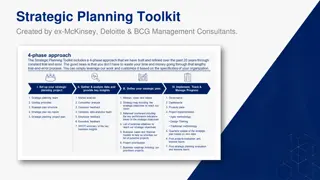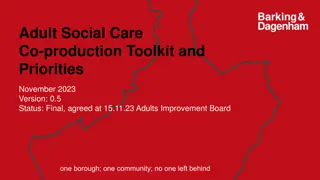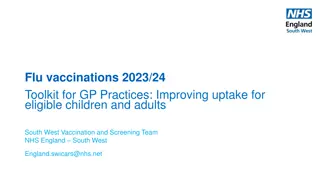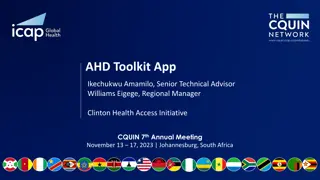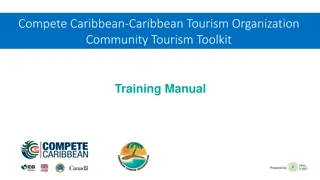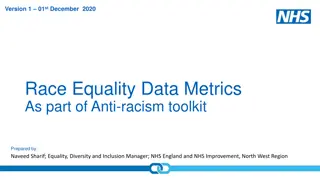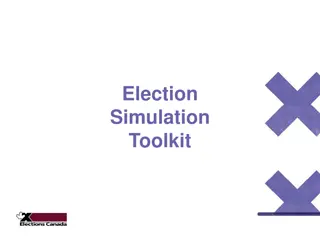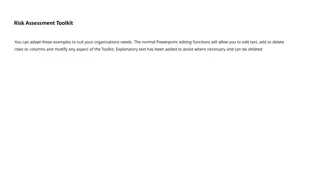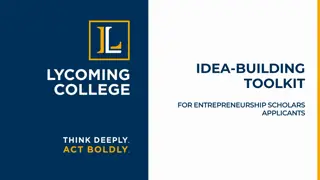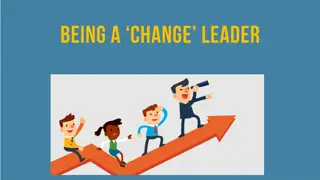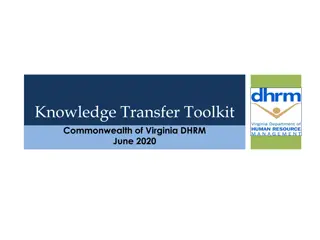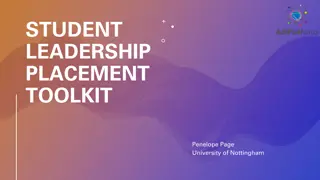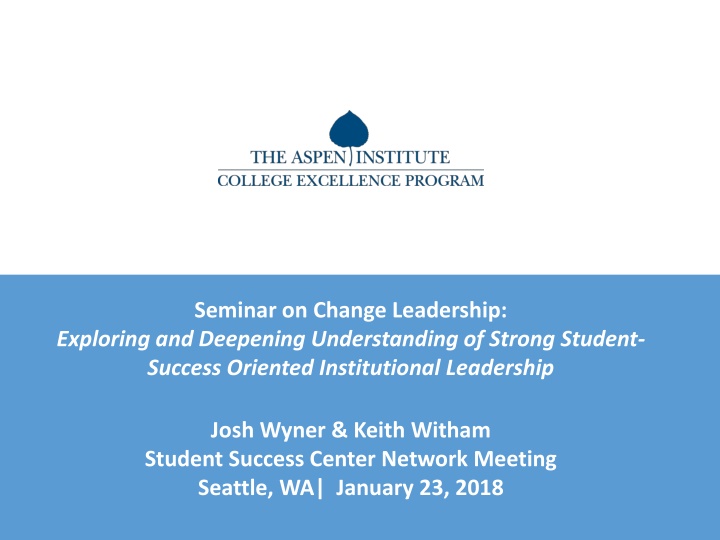
Exploring Strong Student Success Leadership in Seattle Seminar
Dive into the world of strong student success leadership at the Student Success Center Network Meeting in Seattle. Discover what qualities leaders need to drive transformational change, the role of leadership in pathways reform, and how to build institutional leadership capacity for sustained reforms statewide. Join the conversation for insights on building strong leadership across states.
Uploaded on | 0 Views
Download Presentation

Please find below an Image/Link to download the presentation.
The content on the website is provided AS IS for your information and personal use only. It may not be sold, licensed, or shared on other websites without obtaining consent from the author. If you encounter any issues during the download, it is possible that the publisher has removed the file from their server.
You are allowed to download the files provided on this website for personal or commercial use, subject to the condition that they are used lawfully. All files are the property of their respective owners.
The content on the website is provided AS IS for your information and personal use only. It may not be sold, licensed, or shared on other websites without obtaining consent from the author.
E N D
Presentation Transcript
Seminar on Change Leadership: Exploring and Deepening Understanding of Strong Student- Success Oriented Institutional Leadership Josh Wyner & Keith Witham Student Success Center Network Meeting Seattle, WA| January 23, 2018
Seminar on Change Leadership: Guiding Questions for the Session Leadership Matters: What qualities do leaders need to enact and sustain transformational change to improve student success? Internal Change Leadership: What is the leadership role in pathways reform? What are the implications for SSCs work? Application: How can SSCs build institutional leadership capacity to advance scaled, sustained pathways reforms statewide?
Leadership Matters: What qualities do leaders need to enact and sustain transformational change to improve student success?
How can Student Success Centers support building strong leadership capacity across a state?
How can Student Success Centers support building strong leadership capacity across a state?
How can Student Success Centers support building strong leadership capacity across a state? Getting the right people into presidencies
How can Student Success Centers support building strong leadership capacity across a state? Getting the right people into presidencies Ensuring there is a strong bench of leaders within the state
How can Student Success Centers support building strong leadership capacity across a state? Getting the right people into presidencies Ensuring there is a strong bench of leaders within the state Developing current presidents skills in change leadership
Leading Internal Change Management Leading External Strategic Partnerships Define the student success challenge, develop and vision, and create urgency Identify a common agenda and shared vision for change Devise a focused college-wide reform agenda Establish shared accountability on common metrics Align structures and resources to student success Engage in mutually reinforcing activity Build systems to support disciplined execution Maintain consistent and intentional communication Establish routines of inquiry and evidence use Lead from the community college as the connecting link (backbone) Strategic communication
Internal Change Leadership: What is the leadership role in scaled pathways reform? What are the implications for SSCs work?
Todays work: Professional Development for you Train the Trainer How can you teach presidents the change leadership skills needed to enact institutional level reforms? What resources will you need to be successful? How can you build state- wide urgency for guided pathways reform? How can you use change leadership capacities in your own work?
As you experience this session, consider: How might you use a session like this one in your state? What structures are already in place in your state to convene and support leaders? Are there state-based leadership development opportunities? What role could such a session play in a state-wide leadership strategy? How could such sessions be tailored to meet the needs of your state? What support would you need from JFF/Aspen to do this?
What kind of change are we talking about? Guided pathways = Transformational change Alters the culture of the institution by changing select underlying assumptions and institutional behaviors, processes, and products. Is deep and pervasive, affecting the whole institution. Is intentional. Is focused on student access and success. Occurs over time. Eckel, P., Hill, B., & Green, M. (1998). On Change: En Route to Transformation. Washington DC: American Council on Education.
Leading Internal Transformational Change Aligned to Student Success Goals Build College- Wide Ownership for Change Build a System to Support Disciplined Execution Establish Routines of Inquiry and Evidence Use Communicate a Vision and Create Urgency Align Structures and Resources Create Routines of Effective Communication
How do transformational leaders build urgency? Do the data Relate to outcomes that, if improved, would lead to students ultimate goals? Elicit a no response to the question, Is this outcome level acceptable? Include some indicators or trends that can be changed in a reasonable period of time? Inspire action, rather than assign blame? Draw attention to institutional responsibility, rather than student deficits? Broadly share clear, limited, and important data points. Are these data easy to understand?
Community College Graduation Rates 6 yr Graduation Rates 1styr - Did not attempt 9hrs in focus area 16% 34% 1styr - Attempted 9hrs in focus area 40% 1styr - Earned 9hrs in focus area 0% 10% 20% 30% 40% 50%
How do transformational leaders build urgency? Broadly share clear, limited, and important data points. Focus groups Student surveys Activate the student voice. Secret shopper programs
How do transformational leaders build urgency? Broadly share clear, limited, and important data points. Activate the student voice. Remind the audience of the reason for the work, and inspire them to action. Tell a human story.
How do transformational leaders build urgency? Broadly share clear, limited, and important data points. How can SSCs help to build urgency? Activate the student voice. Tell a human story.
Leading Internal Transformational Change Aligned to Student Success Goals Build College- Wide Ownership for Change Build a System to Support Disciplined Execution Establish Routines of Inquiry and Evidence Use Communicate a Vision and Create Urgency Align Structures and Resources Create Routines of Effective Communication
How do transformational leaders build college-wide ownership for change? Ensure the presence of forums to communicate the need for change Use every vehicle to convey the reasons for change Model the vision through how time and money are spent Create time and space to discuss data and the student voice Create shared language and lead the college in dialogue Build a team of champions for the change 26
Building ownership for change How does this look at the state level? Who does this most effectively in your state? How could you find out? How can you use these strategies to engage leaders in your state on increasing ownership for change and reform? How else are these strategies relevant to your practice as a Student Success Center director? Stop and Jot: Take 2 minutes to record ideas on your handout, then we ll discuss.
Activity Spotlight: See Handout Activity: Dear Abby Letters With your table, read Letter A. Each letter comes from an imaginary faculty member who is resistant to guided pathways implementation. Tables will discuss the following questions: Why are these faculty resistant to the change? What is the real problem here? What could the president do to better build college-wide ownership for the change? What strategies might the president use to better build urgency and communicate the need for change?
Activity Spotlight: See Handout Activity: Dear Abby Letters Debrief: What strategies could a president use to build better college-wide ownership for the change? What strategies might a president use to better build urgency and communicate the need for change?
Why might reforms like Guided Pathways implementation fail at the institutional level?
Activity Spotlight: See Handout Why Reforms Fail: Pre-Mortem Analysis Sample Goal: Statewide, colleges will see an increase of 25% of students who complete a credential of no more than 66 credits in no more than three calendar years. Strategy Guided Pathways Build clear pathways Get students on a pathway Help students stay on the pathway Ensure students are learning Take 10 minutes with your table. Assume that, five years from now, your state has failed to achieve this goal. Identify the likely major causes of that mortality. What specifically might happen that could derail the effort? For each cause, what strategies could you employ to anticipate and avert or address the challenges?
Pay attention to why reforms fail. Pay attention to why reforms fail. Reasons Initiatives Fail What can be done? Repeatedly activate the student voice. Blaming the student. Where do you see this in your work? How can SSCs help overcome this barrier? 32
Pay attention to why reforms fail. Pay attention to why reforms fail. Reasons Initiatives Fail What can be done? People don t believe this is going to get done they think it will blow over and the college or state will move on to the next thing. Persistently repeat the message about why and what, using every possible vehicle. Where do you see this in your work? How can SSCs help overcome this barrier? 33
Pay attention to why reforms fail. Pay attention to why reforms fail. Reasons Initiatives Fail What can be done? Maintain discipline for multiple years before taking on major new state-wide initiatives. The colleges are suffering from a failure to focus and from initiative fatigue. Where do you see this in your work? How can SSCs help overcome this barrier? 34
Pay attention to why reforms fail. Pay attention to why reforms fail. Reasons Initiatives Fail What can be done? Build partnerships, considering: Where is the student coming from? Where is the student going next? What students need: That may not be within the college s core strengths. That can be more efficiently delivered by others. For which external resources may be available. The colleges failed to engage external partners so they don t have what they need to ensure student success. Where do you see this in your work? How can SSCs help overcome this barrier? 35
Pay attention to why reforms fail. Pay attention to why reforms fail. Reasons Initiatives Fail What can be done? Use student success-oriented hiring tools to get the right people into presidencies Build capacity of existing presidents through trainings and coaching Build a bench of strong leaders in the state through a state-wide leadership development strategy Leadership commitment and capacity is lacking at the institutional level. Where do you see this in your work? How can SSCs help overcome this barrier? 36
Pay attention to why reforms fail. Pay attention to why reforms fail. Reasons Initiatives Fail What can be done? Ask as each initiative is considered: What is the cost per student? How many students could benefit? If this works, can we afford to scale and sustain? How and when will we know if it works? *Collect the baseline data now! Questions about scale, sustainability, and efficacy are not considered at the outset of initiatives. Where do you see this in your work? How can SSCs help overcome this barrier? 37
Pay attention to why reforms fail. Pay attention to why reforms fail. Reasons Initiatives Fail What can be done? By when will we create a new structure for advising students in the pathways When will pathways be built? When will advising structure be reformed to ensure that students remain on the pathways? How will we know if it works? *Collect the baseline data now! The job never gets done due to incomplete timelines for execution and/or evaluation. Where do you see this in your work? How can SSCs help overcome this barrier? 38
Pay attention to why reforms fail. Pay attention to why reforms fail. Reasons Initiatives Fail What can be done? Streamline communications by: Conducting an inventory of all communications currently sent. Prioritizing types of communications based on importance to completion. Redesigning system for communicating to students to reflect priorities. In the first weeks after enrollment, send students hundreds of emails from different divisions and departments with no prioritization Where do you see this in your work? How can SSCs help overcome this barrier? 39
Pay attention to why reforms fail. Pay attention to why reforms fail. Reasons Initiatives Fail Invest in expensive technology to support advising without first revamping practices and processes for supporting students from entry through completion. What can be done? Before purchasing new software: Redesign processes for onboarding and supporting students through to completion. Map out what information each person needs to be successful in the revamped system. Identify gaps in information based on what is currently available. Where do you see this in your work? How can SSCs help overcome this barrier? 40
Pay attention to why reforms fail. Pay attention to why reforms fail. Reasons Initiatives Fail What can be done? Align PD to guided pathways reform goals. Design and offer professional development completely disconnected from college- wide student success goals. Centralize a significant portion of the professional development budget and decision-making process. Where do you see this in your work? How can SSCs help overcome this barrier? 41
Pay attention to why reforms fail. Pay attention to why reforms fail. Reasons Initiatives Fail What can be done? Establish multi-year budgeting process for student success reform Plan and invest in guided pathways reforms based only on what can be budgeted & accomplished in a single year. Consider costs and benefits over several years, including: Short term investments in advising reform and PD Long term returns in improved retention and graduation Where do you see this in your work? How can SSCs help overcome this barrier? 42
Activity Spotlight: See Handout Activity: Pre-mortem Analysis Debrief: How could an activity like this one be used to teach other concepts?
Activity Spotlight: See Handout Activity: Pre-mortem Analysis Debrief: How could an activity like this one be used to teach other concepts? Benefits: Enables discussions of real challenges (avoiding the dog and pony show ) Invites institutional actors to surface objections Portable and reusable
Application: How can these and other materials be used by SSCs to build institutional leadership capacity in the states?
Turn and Talk: Next Steps With the person next to you, quickly discuss the following questions: 1. What are the problems in your state that could be addressed through stronger change leadership capacity at the institutional level? 2. What structures already exist in your state for building leadership capacity?
Whole Group Discussion: Next Steps 1. What are the problems in your state that could be addressed through stronger change leadership capacity at the institutional level? 2. What structures already exist in your state for building leadership capacity?
Leading Internal Transformational Change Aligned to Student Success Goals Build College- Wide Ownership for Change Build a System to Support Disciplined Execution Establish Routines of Inquiry and Evidence Use Communicate a Vision and Create Urgency Align Structures and Resources Create Routines of Effective Communication Continue to think about how you can do this in your own work.
Leading Internal Change Management Leading External Strategic Partnerships Define the student success challenge, develop and vision, and create urgency Identify a common agenda and shared vision for change Devise a focused college-wide reform agenda Establish shared accountability on common metrics Align structures and resources to student success Engage in mutually reinforcing activity Build systems to support disciplined execution Maintain consistent and intentional communication Establish routines of inquiry and evidence use Lead from the community college as the connecting link (backbone) Strategic communication
What resources are available? 1. Strategies for leading strategic external partnerships and making the case to potential partners (Curricular module) 2. Data templates and assessment tools on transfer (Curricular module) 3. Assessment tool on labor market strategies (soon to be included in the curriculum) 4. Framework and tools for equity leadership (soon to be included in the curriculum)

